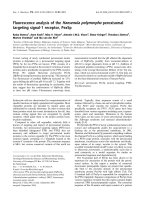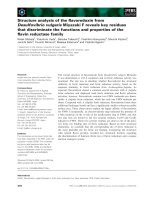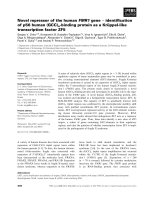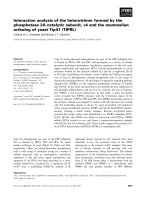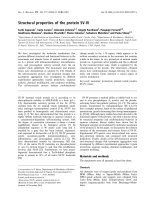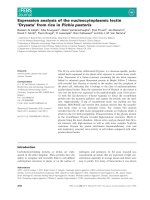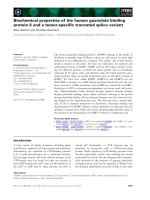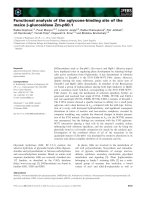Báo cáo khoa học: Biochemical analysis of the human DMC1-I37N polymorphism potx
Bạn đang xem bản rút gọn của tài liệu. Xem và tải ngay bản đầy đủ của tài liệu tại đây (346.82 KB, 9 trang )
Biochemical analysis of the human DMC1-I37N
polymorphism
Juri Hikiba
1
, Yoshimasa Takizawa
1
, Shukuko Ikawa
2
, Takehiko Shibata
2
and Hitoshi Kurumizaka
1
1 Laboratory of Structural Biology, Waseda University, Tokyo, Japan
2 Cellular & Molecular Biology Laboratory, RIKEN Advanced Science Institute, Saitama, Japan
Two successive rounds of nuclear division, meiosis I
and meiosis II, occur with a single round of DNA rep-
lication during meiosis. These processes produce
haploid gametes from diploid cells in eukaryotes [1].
Homologous recombination occurs between homolo-
gous chromosomes during meiosis I. This process
forms chiasma which ensure the correct segregation
of homologous chromosomes into daughter cells at
meiosis I [1–4].
The DMC1 protein was first discovered as a mei-
osis-specific gene, whose mutants are defective in
meiotic homologous recombination in the yeast
Saccharomyces cerevisiae [5]. The DMC1 protein is a
homolog of the bacterial RecA protein, and is highly
conserved from yeast to human [6]. In eukaryotes, a
second RecA homolog, the RAD51 protein, has also
been found [7–12]. The RAD51 protein is produced in
both meiotic and mitotic cells [9,10]. The knockout of
the RAD51 gene results in early embryonic lethality in
mice [13,14], and causes cell death, with the accumula-
tion of spontaneous chromosome breaks, in chicken
DT40 cells [15]. Therefore, the RAD51 protein is
essential for the mitotic homologous recombinational
repair of damaged DNA, as well as meiotic homolo-
gous recombination. However, the DMC1 protein is
produced only in meiotic cells [5,6], indicating its meio-
sis-specific function. Consistent with this, DMC1
knockout mice are viable, but exhibit defects in meiotic
recombination processes and sterility [16,17]. There-
fore, the DMC1 protein is essential in meiotic homo-
logous recombination.
The DMC1 protein promotes homologous-pairing
and strand-exchange reactions in the early stage of
meiotic homologous recombination [18–21]. In
bacteria, the RecA protein catalyzes the homologous-
pairing and strand-exchange reactions [22–25]. These
Keywords
DMC1; DMC1-I37N; homologous
recombination; meiosis; SNP
Correspondence
H. Kurumizaka, Laboratory of Structural
Biology, Graduate School of Advanced
Science and Engineering, Waseda
University, 2-2 Wakamatsu-cho, Shinjuku-ku,
Tokyo 162-8480, Japan
Fax: +81 3 5367 2820
Tel: +81 3 5369 7315
E-mail:
(Received 5 September 2008, revised 6
November 2008, accepted 10 November
2008)
doi:10.1111/j.1742-4658.2008.06786.x
The DMC1 protein, a meiosis-specific DNA recombinase, promotes homol-
ogous pairing and strand exchange. The I37N single nucleotide polymor-
phism of the human DMC1 protein was reported as a result of human
genome sequencing projects. In this study, we purified the human DMC1-
I37N variant, as a recombinant protein. The DMC1 protein is known to
require DNA for efficient ATP hydrolysis. By contrast, the DMC1-I37N
variant efficiently hydrolyzed ATP in the absence of DNA. Like the con-
ventional DMC1 protein, the DMC1-I37N variant promoted strand
exchange, but it required a high Ca
2+
concentration (4–8 mm), a condition
that inactivates the strand-exchange activity of the conventional DMC1
protein. These biochemical differences between the DMC1 and DMC1-
I37N proteins suggest that the DMC1-I37N polymorphism may be a
source of improper meiotic recombination, causing meiotic defects in
humans.
Abbreviations
dsDNA, double-stranded DNA; ssDNA, single-stranded DNA.
FEBS Journal 276 (2009) 457–465 ª 2008 The Authors Journal compilation ª 2008 FEBS 457
reactions occur between the 3¢ single-stranded DNA
(ssDNA) tails generated at DSB sites and the double-
stranded DNA (dsDNA) of the other, intact homo-
logous chromosome. An autosomal-dominant dmc1
mutation, containing a single amino acid substitution,
was isolated as a recombination-defective allele causing
male-specific sterility in mice [26]. This indicates that a
DMC1 polymorphism containing a single amino acid
substitution may cause infertility by a meiotic defect in
mammals. Supporting this hypothesis, the homozygous
DMC1-M200V polymorphism has been identified by
the sequencing of candidate genes from a set of infer-
tile patients [27,28]. In addition, our previous study
revealed that the human DMC1-M200V mutation or
the corresponding Schizosaccharomyces pombe Dmc1
mutation partially impairs the recombination activities
of the DMC1 protein in vitro and in vivo [29]. There-
fore, a DMC1 single-nucleotide polymorphism has the
potential to be a source of human infertility.
In this study, we purified a human DMC1 polymor-
phic variant, DMC1-I37N, in which the Ile37 residue
is replaced by Asn. The DMC1-I37N variant hydro-
lyzed ATP in the absence of DNA, and promoted
strand exchange under high Ca
2+
concentrations,
which were not suitable for the strand-exchange reac-
tion by the conventional DMC1 protein. These find-
ings provide important new insights into the biological
consequences of the DMC1 polymorphic variant in
human meiotic recombination.
Results
The human DMC1-I37N variant hydrolyzes ATP in
the absence of DNA
The DMC1-I37N polymorphism, in which the Ile37
residue is replaced by Asn, was found in human gen-
ome-sequencing projects (NCBI rfSNP ID: rs1129426).
To elucidate the biochemical consequences of this
single amino acid substitution, we purified the human
DMC1-I37N variant, as a bacterially expressed recom-
binant protein, using a method including Ni-NTA
agarose column chromatography, removal of the
hexahistidine tag from the DMC1 portion with throm-
bin protease and heparin Sepharose column chroma-
tography (Fig. 1A). CD analysis revealed that the
DMC1-I37N variant was thermally unstable, com-
pared with the conventional DMC1 protein (Fig. 1B).
We then tested the ATPase activity of the DMC1-
I37N variant. The human DMC1 protein efficiently
hydrolyzes ATP in the presence of ssDNA. In the
125 mm KCl concentration used in this assay, the
ATPase activity of the DMC1 protein was not detected
in the absence of ssDNA (Fig. 2A). By contrast, we
found that the DMC1-I37N variant exhibited detect-
able ATPase activity in the absence of ssDNA
(Fig. 2B). To eliminate the possibility that the ATPase
activity of the DMC1-I37N variant may be stimulated
by contaminating DNA, we subjected the DMC1-I37N
Markers
I37N
WT
132
A
–12
–10
–8
–6
–4
–2
0
2
20 30 40 50 60 70 80 90
Temperature (ºC)
CD (mdeg)
I37N
WT
66
30
17
116
42
200
B
Fig. 1. Purification of the DMC1-I37N variant. (A) The human DMC1 protein and the DMC1-I37N variant were purified by a method including
Ni-NTA agarose column chromatography, removal of the hexahistidine tag from the DMC1 portion with thrombin protease, and heparin
Sepharose column chromatography. The purified DMC1 and DMC1-I37N proteins were analyzed by SDS ⁄ PAGE with Coomassie Brilliant
Blue staining. Lane 1 indicates the molecular mass markers. Lanes 2 and 3 indicate the purified DMC1 and DMC1-I37N proteins, respec-
tively. Asterisks indicate degradation products. (B) Temperature dependence of the CD effect at 222 nm, as a function of temperature, for
the conventional DMC1 protein (closed circles with broken line) and the DMC1-I37N variant (open circles with solid line).
Activity of the human DMC1-I37N variant J. Hikiba et al.
458 FEBS Journal 276 (2009) 457–465 ª 2008 The Authors Journal compilation ª 2008 FEBS
variant sample used in the ATPase assay to agarose
gel electrophoresis, and confirmed that detectable
amounts of DNA were not present in the purified
DMC1-I37N variant sample (data not shown). The
A
280
⁄ A
260
ratio (1.29) of the purified DMC1-I37N pro-
tein was exactly the same as that of the conventional
DMC1 protein, indicating that the DMC1-I37N prepa-
ration did not contain contaminating nucleotides. In
addition, DNaseI treatment did not affect the ATPase
activity of the DMC1-I37N variant (Fig. 2C). There-
fore, the DNA-independent ATPase activity of the
DMC1-I37N variant may not be due to DNA contam-
ination during protein purification.
The ATPase activity of the DMC1 protein is also
stimulated under high salt conditions without DNA.
As shown in Fig. 2D, the DMC1 protein hydrolyzed
ATP in the presence of salt concentrations > 0.5 m
KCl, but did not under low salt conditions (0–0.3 m
KCl). By contrast, the DMC1-I37N variant hydrolyzed
ATP in the presence of low salt concentrations
(< 0.5 m KCl), but did not under high salt conditions
(> 1.0 m KCl) (Fig. 2D). These results indicated that
the DMC1-I37N variant possesses ATPase activity,
but it is very different from that of the conventional
human DMC1 protein.
Strand-exchange and homologous-pairing
activities of the human DMC1-I37N variant
We next tested the strand-exchange activity of the
DMC1-I37N variant. In this assay, /X174 phage
circular ssDNA (5386 bp) and linearized /X174
dsDNA (5386 bp) were used as DNA substrates. Both
intermediate (joint molecule; JM) and complete strand-
exchange products (nicked circular; NC) are detectable
in this assay (Fig. 3A).
We performed the strand-exchange reactions in the
presence of 200 mm KCl, because the human DMC1
protein requires 200 mm KCl for the efficient pro-
motion of strand exchange [20]. Under conditions
with 200 mm KCl, the DMC1-I37N variant was sig-
nificantly defective in the strand-exchange activity
(Fig. 3B). The strand-exchange activity of the DMC1
protein is reportedly enhanced by Ca
2+
ions [21]. We
found that the effects of the presence of Ca
2+
ions in
the strand-exchange reactions were quite different
between the DMC1 and DMC1-I37N proteins. As
shown in Fig. 3C, the DMC1 protein efficiently pro-
moted strand exchange under low Ca
2+
conditions
(lanes 2, 4 and 6), but did not under high Ca
2+
con-
ditions (lanes 8 and 10). By contrast, the DMC1-
I37N variant promoted strand exchange only under
high Ca
2+
conditions (Fig. 3C, lanes 9 and 11), but
did not under low Ca
2+
conditions (Fig. 3C, lanes 3
and 5). Consistent with this, the DMC1-I37N variant
promoted homologous pairing only under high Ca
2+
conditions, in contrast to the conventional DMC1
protein (Fig. 4B). In this assay, a single-stranded oli-
gonucleotide 50-mer and supercoiled dsDNA were
used as the substrates for homologous pairing
(Fig. 4A). These results indicated that the optimal
conditions for homologous pairing and strand
0
0.05
0.1
0.15
0.2
0.25
0.3
No DNA
ssDNA
Time (min)
Phosphate (mM)
Time (min)
Phosphate (mM)
0
0.04
0.08
0.12
0.16
0.2
No DNA
No DNA + DNaseI
0
0.05
0.1
0.15
0.2
WT
I37N
Phosphate (mM)
KCl (M)
0
0.05
0.1
0.15
0.2
0.25
0.3
0 0.3 0.6 0.9 1.2 1.5
0 102030405060
0 102030405060
0 102030405060
Time (min)
Phosphate (mM)
No DNA
ssDNA
AB
CD
Fig. 2. The ATPase activity of the DMC1-
I37N variant. (A) Time course experiments
of ATP hydrolysis by the conventional
DMC1 protein. Open and closed circles indi-
cate the experiments in the presence and
absence of ssDNA, respectively. (B) Time
course experiments of ATP hydrolysis by
the DMC1-I37N variant. Open and closed
circles indicate the experiments in the pres-
ence and absence of ssDNA, respectively.
(C) DNaseI treatment. The ATPase assay
with the DMC1-I37N variant was performed
in the presence of DNaseI. Open and closed
circles indicate the experiments in the pres-
ence and absence of DNaseI, respectively.
(D) KCl titration. The ATPase assays were
performed with the indicated amounts of
KCl. Open and closed circles indicate the
experiments with the DMC1-I37N variant
and the DMC1 protein, respectively.
J. Hikiba et al. Activity of the human DMC1-I37N variant
FEBS Journal 276 (2009) 457–465 ª 2008 The Authors Journal compilation ª 2008 FEBS 459
exchange are very different between the DMC1 and
DMC1-I37N proteins.
No synergistic or additive action between the
DMC protein and the DMC1-I37N variant for
strand exchange
We then tested strand exchange under conditions
where the conventional DMC1 and DMC1-I37N
proteins co-existed in various stoichiometries. These
conditions may mimic the heterozygous DMC1 ⁄
DMC1-I37N situation. As shown in Fig. 5, no syner-
gistic or additive action in the strand-exchange
reaction was observed when the conventional DMC1
and DMC1-I37N proteins co-existed. Under the
conditions suitable for the conventional DMC1 pro-
tein, the DMC1-I37N variant did not affect the
strand-exchange reaction, because the reaction only
depended on the DMC1 concentration (Fig. 5, lanes
1–6). Similarly, the conventional DMC1 protein did
not affect the DMC1-I37N-mediated strand-exchange
reaction under the conditions suitable for the
DMC1-I37N variant (Fig. 5, lanes 7–12). These
results suggested that the DMC1 and DMC1-I37N
proteins may not functionally interact with each
other, when they co-exist.
DNA-binding activity of the human DMC1-I37N
variant
The Ile37 residue of the DMC1 protein is located in
the N-terminal domain. The corresponding N-terminal
domain of the RAD51 protein was suggested to inter-
act directly with DNA [30,31]. Therefore, we tested the
DNA-binding activity of the DMC1-I37N variant. The
DMC1-I37N variant was completely proficient in the
ssDNA binding (Fig. 6A). However, the dsDNA-bind-
ing activity of the DMC1-I37N variant was clearly
decreased, as compared to that of the conventional
DMC1 protein (Fig. 6B). These results suggested that
the N-terminal domain of the DMC1 protein is impor-
tant in dsDNA binding.
+
ssDNA dsDNA
JM
(joint molecule)
NC
(nicked circular
dsDNA)
A
+
ssDNA
No protein
WT
I37N
dsDNA
NC
JM
ssDNA
B
WT
I37N
891011
1234567
1234567
CaCl
2
(mM)
WT
WT
WT
WT
I37N
I37N
I37N
I37N
no protein
01248
C
dsDNA
NC
JM
ssDNA
Fig. 3. The strand-exchange activity of the DMC1-I37N variant. (A) A schematic representation of the strand-exchange assay. (B) The DMC1
protein or the DMC1-I37N variant was incubated with /X174 circular ssDNA (20 l
M) at 37 °C for 10 min. After the addition of RPA, /X174
linear dsDNA (20 l
M) was added to initiate the reaction. The reactions were continued for the indicated times. The DNA products were then
deproteinized, and were separated by 1% agarose gel electrophoresis in 1· TAE buffer at 3.3 VÆcm
)1
for 4 h. The products were visualized
by SYBR Gold (Invitrogen) staining. Joint molecules and nicked circular DNA are indicated by JM and NC, respectively. Lane 1 indicates a
negative control experiment without the DMC1 protein. Lanes 2–4 indicate experiments with the DMC1 protein, and lanes 5–7 indicate
experiments with the DMC1-I37N variant. Protein concentrations were 3.75 l
M (lanes 2 and 5), 7.5 lM (lanes 3 and 6) and 15 lM (lanes 4
and 7). (C) The strand-exchange assay with CaCl
2
. Reactions were performed in the presence of the DMC1 (6 lM) or DMC1-I37N (6 lM)
protein in the same manner as described in (B), except for the presence of the indicated amounts of CaCl
2
.
Activity of the human DMC1-I37N variant J. Hikiba et al.
460 FEBS Journal 276 (2009) 457–465 ª 2008 The Authors Journal compilation ª 2008 FEBS
Discussion
Human genome sequencing projects have identified
many SNPs in the DMC1 gene locus. The DMC1-
I37N polymorphism contains an amino acid substi-
tution in the coding region of the DMC1 gene. The
distribution of the DMC1-I37N polymorphism in the
human population has not yet been elucidated. In this
study, we purified the DMC1-I37N variant, and com-
pared its biochemical properties with those of the con-
ventional DMC1 protein. We have previously studied
the human DMC1-M200V variant [29], which is
suspected to be a source of infertility [27,28]. The
DMC1-M200V variant was moderately defective in the
recombinase activity in vitro and in vivo; however, its
biochemical and structural characteristics are not sig-
nificantly different from those of the DMC1 protein
[29]. In contrast to the DMC1-M200V variant, in this
study, we found that the DMC1-I37N variant pos-
sesses quite different biochemical characteristics from
those of the DMC1 protein. The DMC1 protein
requires ssDNA or a high salt concentration for effi-
cient ATP hydrolysis. We found that the DMC1-I37N
variant hydrolyzed ATP in the absence of DNA or the
presence of a low salt concentration. The DMC1-I37N
variant promoted homologous pairing and strand
exchange under high Ca
2+
conditions, but was com-
pletely defective under the conditions suitable for the
conventional DMC1 protein. Conversely, under such
high Ca
2+
conditions, the DMC1 protein did not effi-
ciently promote the strand-exchange reaction. There-
fore, the DMC1-I37N variant has very different
optimal conditions for its recombinase activity from
those for the conventional DMC1 protein.
Given that the conventional DMC1 protein has been
evolutionally optimized for promoting proper meiotic
recombination, the DMC1-I37N variant may cause seri-
ous problems in meiosis. The I37N mutant, which
requires a high Ca
2+
concentration for its recombinase
activity, may be inactive in pachytene spermatocytes,
because the Ca
2+
concentration of pachytene spermato-
cytes is 30–40 nm in mammals [30]. Because the
DMC1-I37N variant neither activated nor inhibited the
B
WT
I37N
CaCl
2
(mM)
WT
WT
WT
WT
I37N
I37N
I37N
I37N
No protein
8 9 10 11
1234567
01248
ssDNA dsDNA
D-loop
A
ssDNA
D-loops
Fig. 4. The homologous-pairing activity of the DMC1-I37N variant.
(A) A schematic representation of the homologous-pairing assay.
(B) The DMC1 (4 l
M) or DMC1-I37N (4 lM) protein was incubated
with the
32
P-labeled single-stranded oligonucleotide 50-mer in the
presence of the indicated amounts of CaCl
2
(final concentration
1–8 m
M), and the reaction was initiated by adding the supercoiled
dsDNA. The reactions were conducted for 8 min, and the deprotei-
nized products were resolved by 0.8% agarose gel electrophoresis
in 1· TAE buffer at 3.3 VÆcm
)1
for 2.5 h. Bands were visualized by
an FLA-7000 imaging analyzer (Fujifilm, Tokyo, Japan).
89
10 11 12
WT
I37N
1234567
0
0
6
06
3
3
4.5
1.5
0
4.5
1.5 0
0
6
06
3
3
4.5
1.5
0
4.5
1.5
200 m
M KCl
50 m
M KCl
8 m
M CaCl
2
dsDNA
NC
JM
ssDNA
Fig. 5. The strand-exchange assay in the presence of various
amounts of the DMC1 protein and the DMC1-I37N variant. The
indicated amounts of the DMC1 and DMC1-I37N proteins (total
6 l
M) were incubated with /X174 circular ssDNA at 37 °C for
10 min. After the addition of RPA, /X174 linear dsDNA was added
to initiate the reaction. The reactions were continued for 60 min.
J. Hikiba et al. Activity of the human DMC1-I37N variant
FEBS Journal 276 (2009) 457–465 ª 2008 The Authors Journal compilation ª 2008 FEBS 461
strand-exchange reaction promoted by the DMC1
protein when it co-existed, the heterozygous
DMC1 ⁄ DMC1-I37N situation may not cause serious
meiotic defects, if a sufficient amount of the DMC1 pro-
tein is produced. An infertile woman, who is homozy-
gous for the human DMC1-M200V polymorphism, has
been identified in a set of infertile patients [27,28], and a
mouse DMC1 mutant containing a single amino acid
substitution (Ala272 to pro, A272P) causes male-specific
infertility [26]. These DMC1-M200V and DMC1-A272P
proteins are moderately and significantly defective in the
recombinase activity in vitro, respectively [26,29]. We
report here that the DMC1-I37N protein is significantly
defective in the recombinase activity under the condi-
tions suitable for the DMC1 protein. Therefore, the
DMC1-I37N polymorphism may have the potential to
be a source of human infertility. Extensive SNP analyses
of the DMC1-I37N polymorphism in the human popu-
lation and in sets of infertile patients may be required to
understand the relationship between the DMC1-I37N
polymorphism and human infertility.
The helical-filament structure is considered to be the
active form for the recombinase activity in the DMC1
and RAD51 proteins and their orthologs. We and oth-
ers [29,31–34] previously suggested that the N-terminal
domain of the RAD51 and DMC1 proteins constitutes
a DNA-binding path that runs between two consecu-
tive N-terminal domains in the filament structure. This
putative DNA-binding path may function to guide
DNA into the DNA-binding loops, L1 and L2, which
are located inside the filament [35–39]. We found that
the DMC1-I37N variant is moderately defective in
dsDNA binding. This result supports the idea that the
N-terminal domain of the DMC1 protein functions as
part of the DNA-binding path.
Materials and methods
Purification of the human DMC1 protein and the
DMC1-I37N variant
The human DMC1 protein and the DMC1-I37N variant
were each overexpressed with the pET-15b plasmid system
(Novagen, Darmstadt, Germany) in Escherichia coli strain
BL21(DE3) Codon Plus (Stratagene, La Jolla, CA, USA), as
hexahistidine-tagged proteins. The proteins were then puri-
fied by the method described previously [40]. Briefly, cells
producing the proteins were harvested and lyzed by sonica-
tion in buffer A (50 mm Tris ⁄ HCl buffer pH 8.0, containing
0.5 m NaCl, 2 mm 2-mercaptoethanol, 10% glycerol and
5mm imidazole) on ice. The cell lysate was centrifuged at
27 700 g for 20 min, and the supernatant was gently mixed
by the batch method with 4 mL of Ni-NTA agarose beads
(QIAGEN, Hilden, Germany) at 4 °C for 1 h. The protein-
bound beads were packed into an Econo-column (Bio-Rad
Laboratories, Hercules, CA, USA) and washed with 30 col-
umn volumes of buffer A. The human DMC1 protein was
eluted in a 20 column volume linear gradient of 5–500 mm
imidazole in buffer A. The peak fractions were collected, and
thrombin protease (2 unitsÆmg
)1
of the human DMC1 pro-
tein; GE Healthcare Biosciences, Uppsala, Sweden) was
added to remove the His-tag. The samples were then immedi-
ately dialyzed overnight at 4 °C in buffer B (20 mm Tris ⁄ HCl
buffer pH 8.0, containing 0.2 m KCl, 0.25 mm EDTA, 2 mm
2-mercaptoethanol and 10% glycerol). The human DMC1
protein, which now lacked the His-tag, was subjected to
chromatography on a 4 mL Heparin-Sepharose (GE Health-
care Biosciences) column. The column was washed with 20
column volumes of buffer B, and the protein was eluted with
a 20 column volume linear gradient of 0.2–1.0 m KCl in
buffer B. The purified proteins were concentrated with a
centrifugal cartridge, and the buffer was exchanged with
BA
1234567812345678
ssDNA
dsDNA
WT
I37N
No protein
No protein
WT
I37N
No protein
No protein
Fig. 6. The DNA-binding activity of the DMC1-I37N variant. (A) The /X174 circular ssDNA (20 lM) was mixed with the DMC1 protein (lanes
2–4) or the DMC1-I37N variant (lanes 6–8), and the reactions were conducted at 37 °C for 10 min. Samples were then analyzed by 0.8%
agarose gel electrophoresis in 1· TAE buffer at 3.3 VÆcm
)1
for 2.5 h. The bands were visualized by ethidium bromide staining. Protein con-
centrations were 3.75 l
M (lanes 2 and 6), 7.5 lM (lanes 3 and 7) and 15 lM (lanes 4 and 8). (B) The supercoiled /X174 dsDNA (10 lM) was
used instead of the ssDNA.
Activity of the human DMC1-I37N variant J. Hikiba et al.
462 FEBS Journal 276 (2009) 457–465 ª 2008 The Authors Journal compilation ª 2008 FEBS
20 mm Hepes–KOH buffer (pH 7.5), containing 500 mm
KCl, 0.25 mm EDTA, 2 mm 2-mercaptoethanol and 10%
glycerol. The protein concentration was determined using the
Bradford method, with BSA as the standard.
CD measurements
CD spectra of the DMC1 proteins (4 lm) were recorded on
a JASCO J-820 spectropolarimeter (JASCO, Tokyo,
Japan). All CD experiments were performed in a buffer
containing 20 mm potassium phosphate (pH 7.0) and
50 mm KCl.
The strand-exchange assay
The human DMC1 protein or the DMC1-I37N variant was
incubated at 37 °C for 10 min with 20 lm /X174 circular
ssDNA, in 10 lLof20mm Hepes–KOH buffer (pH 7.5),
containing 1 mm ATP, 1 mm MgCl
2
, 0.1 mgÆmL
)1
BSA,
20 mm creatine phosphate and 75 lgÆmL
)1
creatine kinase.
After this incubation, 2 lm RPA and the indicated amounts
of KCl and CaCl
2
were added to the reaction mixture,
which was incubated at 37 °C for 10 min. The reactions
were then initiated by the addition of 20 lm /X174 linear
dsDNA, and were continued for 1 h. The reactions were
stopped by the addition of 0.1% SDS and 1.7 mgÆmL
)1
proteinase K (Roche Applied Science, Basel, Switzerland),
and the samples were further incubated at 37 °C for
20 min. The deproteinized reaction products were separated
by 1% agarose gel electrophoresis in 1· TAE buffer (ice-
cold, 40 mm Tris-acetate and 1 mm EDTA) at 3.0 VÆcm
)1
for 4 h. The products were visualized by SYBR Gold (Invi-
trogen, Carlsbad, CA, USA) staining.
The D-loop assay
The reactions were conducted in 10 l Lof20mm Tris ⁄ HCl
buffer (pH 8.0), containing 1 mm MgCl
2
,1mm ATP, 2 mm
creatine phosphate, 75 lgÆmL
)1
creatine kinase, 0.1 mgÆmL
)1
BSA and the indicated amounts of CaCl
2
(final concentration
1–8 mm), and were started by incubating either the DMC1
protein (4 lm) or the DMC1-I37N variant (4 lm) with 1 lm
of
32
P-labeled ssDNA 50-mer at 37 °C for 5 min. For the
ssDNA substrate, the following HPLC-purified oligonucleo-
tide was purchased from Roche Applied Science: 50-mer,
5¢-ATTTCATGCTAGACAGAAGAATTCTCAGTAACTT
CTTTGTGCTGTGTGTA-3¢. The 5¢-ends of the oligo-
nucleotides were labeled with T4 polynucleotide kinase
(New England Biolabs, Ipswich, MA, USA) in the presence
of [
32
P]ATP[cP] at 37 °C for 30 min. Afterwards, the super-
coiled dsDNA (pGsat4; final concentration of 30 lm) was
added, and the reaction mixtures were further incubated
for 8 min. The reactions were terminated by the addition of
1% SDS and 1.7 mgÆmL
)1
proteinase K (Roche Applied
Science), and the samples were further incubated at 37 °C for
15 min. The products were resolved by 0.8% agarose gel elec-
trophoresis in 1· TAE buffer at 3.3 VÆcm
)1
for 2.5 h, and
were visualized and quantitated by an FLA-7000 imaging
analyzer (Fujifilm, Tokyo, Japan).
Assays for DNA binding
The /X174 circular ssDNA (20 lm) or the supercoiled
/X174 dsDNA (10 lm) was mixed with the human DMC1
protein or the DMC1-I37N variant in 10 lL of a standard
reaction solution, containing 20 mm Hepes–KOH (pH 7.5),
1mm dithiothreitol, 0.1 mgÆmL
)1
BSA, 1 mm MgCl
2
,
250 mm KCl, 5% glycerol and 1 mm ATP. The reaction
mixtures were incubated at 37 °C for 10 min, and then
analyzed by 0.8% agarose gel electrophoresis in 1· TAE
buffer at 3.3 VÆcm
)1
for 2.5 h. The bands were visualized
by ethidium bromide staining.
ATPase activity
The human DMC1 protein or the DMC1-I37N variant was
incubated in 20 mm Hepes–KOH (pH 7.5), 125 mm KCl,
1mm MgCl
2
,1mm dithiothreitol and 0.1 mgÆmL
)1
BSA in
the presence or absence of ssDNA. For the experiments
with DNaseI treatment, 1 unit of DNaseI (Roche Applied
Science) was added to the reaction mixture, which was fur-
ther incubated at 37 °C for 30 min. The reaction was per-
formed at 37 °C. After a 10 min preincubation in the
absence of ATP (Roche Applied Science; ATP sodium salt),
the reaction was initiated by adding 1 mm ATP. At the
indicated times, 20 lL of the reaction mixture was mixed
with 30 lL of 100 mm EDTA to quench the reaction. The
amount of inorganic phosphate released was determined by
a colorimetric assay, as described previously [39].
Acknowledgements
Funding for this work was provided by the Program
for Promotion of Basic Research Activities for Innova-
tive Biosciences (PROBRAIN) to TS and HK, and
was also provided in part by Grants-in-Aid from the
Ministry of Education, Culture, Sports, Science and
Technology, Japan.
References
1 Petronczki M, Siomos MF & Nasmyth K (2003) Un
me
´
nage a
`
quatre: the molecular biology of chromosome
segregation in meiosis. Cell 112, 423–440.
2 Bishop DK & Zickler D (2004) Early decision: meiotic
crossover interference prior to stable strand exchange
and synapsis. Cell 117, 9–15.
J. Hikiba et al. Activity of the human DMC1-I37N variant
FEBS Journal 276 (2009) 457–465 ª 2008 The Authors Journal compilation ª 2008 FEBS 463
3 Neale MJ & Keeney S (2006) Clarifying the mechanics
of DNA strand exchange in meiotic recombination.
Nature 442, 153–158.
4 Kleckner N (2006) Chiasma formation: chromatin ⁄ axis
interplay and the role(s) of the synaptonemal complex.
Chromosoma 115, 175–194.
5 Bishop DK, Park D, Xu L & Kleckner N (1992)
DMCI: a meiosis-specific yeast homolog of E. coli recA
required for recombination, synaptonemal complex for-
mation, and cell cycle progression. Cell 69, 439–456.
6 Habu T, Taki T, West A, Nishimune Y & Morita T
(1996) The mouse and human homologs of DMC1 , the
yeast meiosis-specific homologous recombination gene,
have a common unique form of exon-skipped transcript
in meiosis. Nucleic Acids Res 24, 470–477.
7 Aboussekhra A, Chanet R, Adjiri A & Fabre F (1992)
Semidominant suppressors of Srs2 helicase mutations of
Saccharomyces cerevisiae map in the RAD51 gene,
whose sequence predicts a protein with similarities to
procaryotic RecA proteins. Mol Cell Biol 12, 3224–3234.
8 Basile G, Aker M & Mortimer RK (1992) Nucleotide
sequence and transcriptional regulation of the yeast
recombinational repair gene RAD51. Mol Cell Biol 12,
3235–3246.
9 Shinohara A, Ogawa H & Ogawa T (1992) Rad51 pro-
tein involved in repair and recombination in S. cerevisi-
ae is a RecA-like protein. Cell 69, 457–470.
10 Shinohara A, Ogawa H, Matsuda Y, Ushio N, Ikeo K
& Ogawa T (1993) Cloning of human, mouse and fis-
sion yeast recombination genes homologous to RAD51
and recA. Nat Genet 4, 239–243.
11 Morita T, Yoshimura Y, Yamamoto A, Murata K,
Mori M, Yamamoto H & Matsushiro A (1993) A
mouse homolog of the Escherichia coli recA and Sac-
charomyces cerevisiae RAD51 genes. Proc Natl Acad Sci
USA 90, 6577–6580.
12 Yoshimura Y, Morita T, Yamamoto A & Matsushiro
A (1993) Cloning and sequence of the human RecA-like
gene cDNA. Nucleic Acids Res 21, 1665.
13 Lim DS & Hasty P (1996) A mutation in mouse rad51
results in an early embryonic lethal that is suppressed
by a mutation in p53. Mol Cell Biol 16, 7133–7143.
14 Tsuzuki T, Fujii Y, Sakumi K, Tominaga Y, Nakao K,
Sekiguchi M, Matsushiro A, Yoshimura Y & Morita T
(1996) Targeted disruption of the Rad51 gene leads to
lethality in embryonic mice. Proc Natl Acad Sci USA
93, 6236–6240.
15 Sonoda E, Sasaki MS, Buerstedde JM, Bezzubova O,
Shinohara A, Ogawa H, Takata M, Yamaguchi-Iwai Y
& Takeda S (1998) Rad51-deficient vertebrate cells
accumulate chromosomal breaks prior to cell death.
EMBO J 17, 598–608.
16 Pittman DL, Cobb J, Schimenti KJ, Wilson LA,
Cooper DM, Brignull E, Handel MA & Schimenti JC
(1998) Meiotic prophase arrest with failure of chromo-
some synapsis in mice deficient for Dmc1, a germline-
specific RecA homolog. Mol Cell 1, 697–705.
17 Yoshida K, Kondoh G, Matsuda Y, Habu T, Nishi-
mune Y & Morita T (1998) The mouse RecA-like gene
Dmc1 is required for homologous chromosome synapsis
during meiosis. Mol Cell 1, 707–718.
18 Li Z, Golub EI, Gupta R & Radding CM (1997)
Recombination activities of HsDmc1 protein, the mei-
otic human homolog of RecA protein. Proc Natl Acad
Sci USA 94, 11221–11226.
19 Hong EL, Shinohara A & Bishop DK (2001) Saccharo-
myces cerevisiae Dmc1 protein promotes renaturation of
single-strand DNA (ssDNA) and assimilation of ssDNA
into homologous super-coiled duplex DNA. J Biol
Chem 276, 41906–41912.
20 Sehorn MG, Sigurdsson S, Bussen W, Unger VM &
Sung P (2004) Human meiotic recombinase Dmc1 pro-
motes ATP-dependent homologous DNA strand
exchange. Nature 429, 433–437.
21 Bugreev DV, Golub EI, Stasiak AZ, Stasiak A &
Mazin AV (2005) Activation of human meiosis-specific
recombinase Dmc1 by Ca
2+
. J Biol Chem 280, 26886–
26895.
22 Shibata T, DasGupta C, Cunningham RP & Radding
CM (1979) Purified Escherichia coli recA protein cata-
lyzes homologous pairing of superhelical DNA and
single-stranded fragments. Proc Natl Acad Sci USA
76, 1638–1642.
23 McEntee K, Weinstock GM & Lehman IR (1979) Initi-
ation of general recombination catalyzed in vitro by the
recA protein of Escherichia coli. Proc Natl Acad Sci
USA 76, 2615–2619.
24 Cox MM & Lehman IR (1981) Directionality and
polarity in recA protein-promoted branch migration.
Proc Natl Acad Sci USA 78, 6018–6022.
25 Kahn R, Cunningham RP, DasGupta C & Radding
CM (1981) Polarity of heteroduplex formation pro-
moted by Escherichia coli recA protein. Proc Natl Acad
Sci USA 78, 4786–4790.
26 Bannister AA, Pezza RJ, Donaldson JR, de Rooij DG,
Schimenti KJ, Camerini-Otero RD & Schimenti JC
(2007) A dominant, recombination-defective allele of
Dmc1 causing male-specific sterility. PLoS Biol 5, 1–10.
27 Mandon-Pe
´
pin B, Derbois C, Matsuda F, Cotinot C,
Wolgemuth DJ, Smith K, McElreavey K, Nicolas A &
Fellous M (2002) Human infertility: meiotic genes as
potential candidates. Gynecol Obstet Fertil 30, 817–821.
28 Mandon-Pe
´
pin B, Touraine P, Kuttenn F, Derbois C,
Rouxel A, Matsuda F, Nicolas A, Cotinot C & Fellous
M (2008) Genetic investigation of four meiotic genes in
women with premature ovarian failure. Eur J Endocri-
nol 158, 107–115.
29 Hikiba J, Hirota K, Kagawa W, Ikawa S, Kinebuchi T,
Sakane I, Takizawa Y, Yokoyama S, Mandon-Pe
´
pin B,
Nicolas A et al. (2008) Structural and functional analy-
Activity of the human DMC1-I37N variant J. Hikiba et al.
464 FEBS Journal 276 (2009) 457–465 ª 2008 The Authors Journal compilation ª 2008 FEBS
ses of the DMC1–M200V polymorphism found in the
human population. Nucleic Acids Res 36, 4181–4190.
30 Herrera E, Salas K, Lagos N, Benos DJ & Reyes G
(2001) Temperature dependence of intracellular Ca
2+
homeostasis in rat meiotic and postmeiotic spermato-
genic cells. Reproduction 122, 545–551.
31 Aihara H, Ito Y, Kurumizaka H, Yokoyama S & Shi-
bata T (1999) The N-terminal domain of the human
Rad51 protein binds DNA: structure and a DNA bind-
ing surface as revealed by NMR. J Mol Biol 290 , 495–
504.
32 Zhang XP, Lee KI, Solinger JA, Kiianitsa K & Heyer
WD (2005) Gly-103 in the N-terminal domain of Sac-
charomyces cerevisiae Rad51 protein is critical for DNA
binding. J Biol Chem 280, 26303–26311.
33 Shin DS, Pellegrini L, Daniels DS, Yelent B, Craig L,
Bates D, Yu DS, Shivji MK, Hitomi C, Arvai AS et al.
(2003) Full-length archaeal Rad51 structure and
mutants: mechanisms for RAD51 assembly and control
by BRCA2. EMBO J 22, 4566–4576.
34 Chen L-T, Ko T-P, Chang Y-W, Lin K-A, Wang AH-J
& Wang T-F (2007) Structural and functional analyses
of five conserved positively charged residues in the L1
and N-terminal DNA binding motifs of archaeal RadA
protein. PLoS ONE 9, 1–11.
35 Conway AB, Lynch TW, Zhang Y, Fortin GS, Fung
CW, Symington LS & Rice PA (2004) Crystal structure
of a Rad51 filament. Nat Struct Mol Biol 11, 791–796.
36 Wu Y, He Y, Moya IA, Qian X & Luo Y (2004) Crys-
tal structure of archaeal recombinase RadA: a snapshot
of its extended conformation. Mol Cell 15, 423–435.
37 Wu Y, Qian X, He Y, Moya IA & Luo Y (2005) Crys-
tal structure of an ATPase-active form of Rad51 homo-
log from Methanococcus voltae. J Biol Chem 280,
722–728.
38 Chen Z, Yang H & Pavletich NP (2008) Mechanism of
homologous recombination from the RecA–
ssDNA ⁄ dsDNA structures. Nature 453, 489–494.
39 Matsuo Y, Sakane I, Takizawa Y, Takahashi M & Ku-
rumizaka H (2006) Roles of the human Rad51 L1 and
L2 loops in DNA binding. FEBS J 273, 3148–3159.
40 Kinebuchi T, Kagawa W, Enomoto R, Tanaka K,
Miyagawa K, Shibata T, Kurumizaka H & Yokoyama
S (2004) Structural basis for octameric ring formation
and DNA interaction of the human homologous-pairing
protein Dmc1. Mol Cell 14, 363–374.
J. Hikiba et al. Activity of the human DMC1-I37N variant
FEBS Journal 276 (2009) 457–465 ª 2008 The Authors Journal compilation ª 2008 FEBS 465


